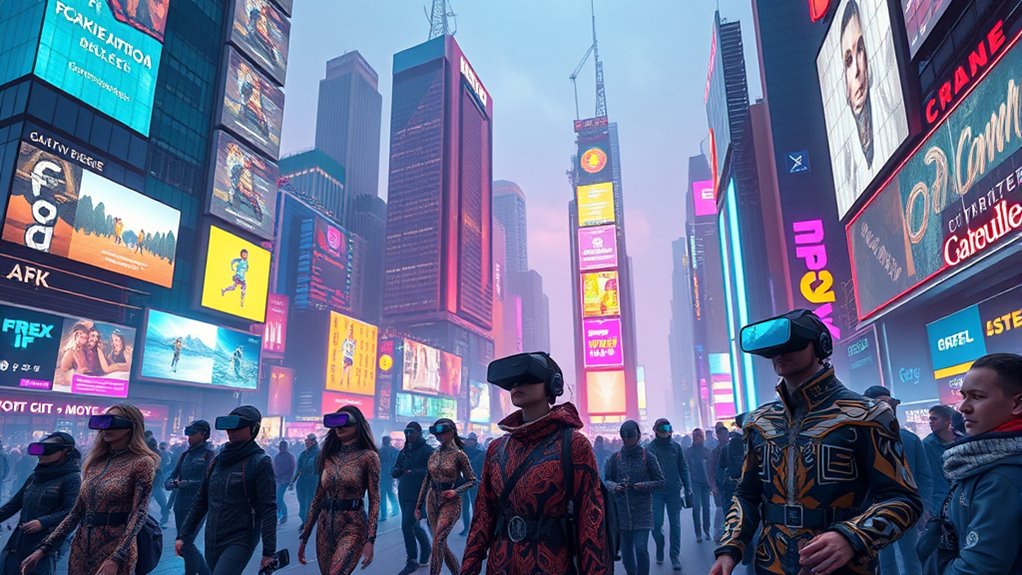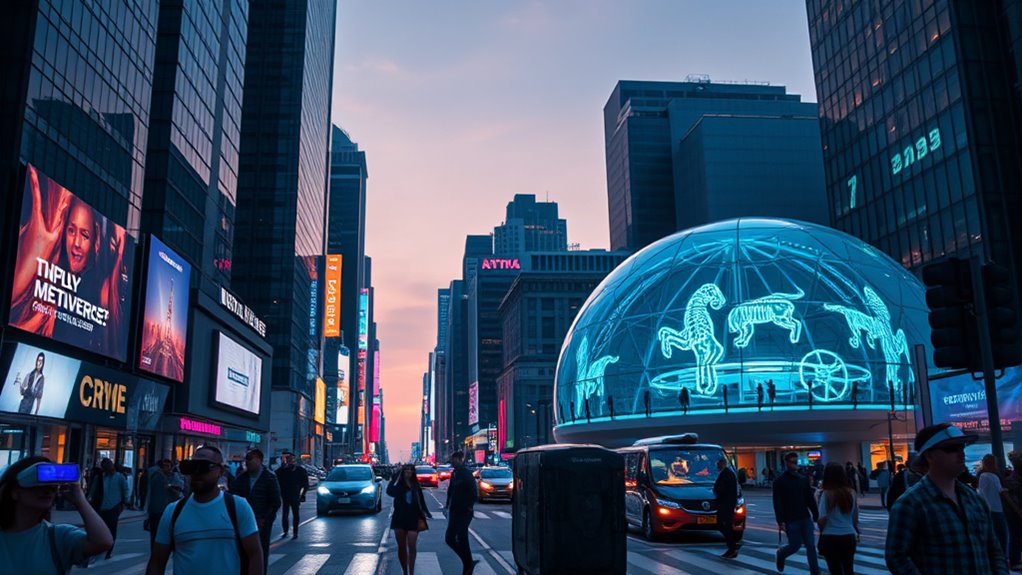By 2025, the metaverse is not just a fleeting trend but a growing digital frontier that transforms how you work, socialize, and explore. Immersive virtual environments, thriving economies, and advanced avatar customization let you express yourself authentically and connect meaningfully. As virtual and physical worlds increasingly merge, your digital identity becomes central to daily life. If you want to understand how this evolution shapes your future, explore the exciting developments coming next.
Key Takeaways
- Virtual worlds will become integral to daily life, blending real and digital experiences seamlessly by 2025.
- Robust digital economies will make virtual assets like goods and real estate valuable and tradable.
- Advanced avatar customization will foster deeper self-expression and identity, enhancing social and professional interactions.
- Virtual environments will support diverse activities, from work meetings to entertainment, blurring boundaries between physical and digital.
- Technological innovations will solidify the metaverse as a sustainable, thriving frontier rather than a passing trend.

Have you ever wondered what the metaverse will look like in 2025? It’s a question many of us ask as technology advances at a rapid pace. By then, you might find yourself immersed in virtual worlds that feel almost indistinguishable from reality. These environments will likely be driven by thriving virtual economies, where digital assets aren’t just pixels but valuable commodities. You’ll be able to buy, sell, and trade virtual goods, from clothing for your avatar to real estate within these digital spaces. This economy will be more than just a game; it’ll be a full-fledged marketplace that fuels innovation and creativity. You might even generate income through virtual businesses, collaborating with others across the globe without ever leaving your home.
As these digital economies grow, avatar customization will become a central feature of the metaverse experience. You’ll have unprecedented control over how you present yourself, with options to fine-tune everything from facial features to outfits and accessories. Your avatar will serve as your personal brand, a reflection of your style and identity. This customization won’t be limited to mere aesthetics; it will extend to functionality, allowing you to equip your avatar with skills or tools that enhance your experience. For example, you could have a professional avatar for work meetings or a creative one for social gatherings, all tailored to your preferences. The ability to craft a unique digital persona will foster deeper engagement and self-expression, making interactions feel more authentic and personalized.
In 2025, the lines between the physical and virtual worlds will blur further, with virtual economies fueling real-world livelihoods. You might attend virtual concerts, shop in digital malls, or even participate in virtual tourism, all while your avatar navigates these spaces seamlessly. The evolution of avatar customization will empower you to stand out and connect more meaningfully with others, whether for social, professional, or recreational purposes. As these features become more sophisticated, you’ll find yourself investing time and resources into perfecting your digital identity. The metaverse will no longer be just a side hobby but a core part of daily life, shaping how you work, socialize, and play. Additionally, high-quality projectors will play a crucial role in creating immersive virtual environments, enhancing how we experience digital worlds at home. It’s an exciting time, and by 2025, you could be at the forefront of this digital frontier, living and thriving within it.
Frequently Asked Questions
How Will Privacy Be Protected in the Metaverse?
You’ll see privacy protected through strict data ownership policies and advanced identity verification methods. As you navigate the metaverse, your control over personal data will be prioritized, ensuring you decide what information to share. Enhanced identity verification will prevent impersonation and fraud, giving you confidence that your virtual identity remains secure. Developers and platforms will implement these measures to create a safer, more trustworthy environment for everyone.
What Are the Ethical Concerns Surrounding Metaverse Development?
Exploring the metaverse’s ethical landscape is like walking a tightrope over a digital abyss. You must consider issues like safeguarding digital identity and ensuring virtual ownership rights. As you develop these virtual worlds, you’re accountable for preventing exploitation, bias, and privacy breaches. Ethical concerns challenge you to create inclusive, transparent environments that respect user rights, balancing innovation with responsibility to avoid turning the metaverse into a dystopian playground.
Will the Metaverse Replace Physical Social Interactions?
You might find the metaverse complements physical social interactions rather than replacing them. While virtual intimacy offers new ways to connect, it can lack social authenticity, making it hard to fully substitute face-to-face encounters. The metaverse will likely enhance your social experiences by providing immersive environments, but genuine human connection remains rooted in physical presence. So, expect a blend of both worlds rather than one replacing the other entirely.
How Accessible Will the Metaverse Be for Differently-Abled Users?
You’ll find the metaverse becoming more accessible for differently-abled users through advances in accessible design and assistive technology. Developers are increasingly integrating features like voice commands, haptic feedback, and customizable interfaces to guarantee everyone can participate. As these innovations grow, you’ll experience more inclusive virtual environments that cater to diverse needs, making the metaverse a space where accessibility isn’t an afterthought but a fundamental component.
What Is the Environmental Impact of Metaverse Infrastructure?
You might be concerned about the environmental impact of metaverse infrastructure. It consumes significant energy, often relying on non-renewable sources, which affects sustainability. To reduce digital waste and carbon footprint, developers are adopting sustainable energy solutions and optimizing data centers. By making these efforts, you can help guarantee the metaverse becomes more eco-friendly, minimizing its environmental footprint and supporting a greener digital future.
Conclusion
By 2025, the metaverse stands at a crossroads, like a budding tree facing the storm or the sun. Will it wither away as just a fleeting trend, or blossom into a new digital frontier? The choice lies in your hands—embrace its potential or watch it fade into the shadows of yesterday’s dreams. The future’s canvas is blank, waiting for you to paint your story in pixels and possibility.










